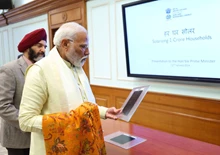
Vijaya Dashami, also known as Dussehra is an auspicious day associated with Lord Rama, son of King Dasharatha who eliminated Ravana. Apart from this on this day, Goddess Durga put an end to a demon named Mahishasura's tyranny by killing him with her trident in a battle that lasted for nine days. Thus, the nine-day long battle is celebrated as the festival of Shardiya Navratri in the month of Ashwin, Shukla Paksha that pays ode to Mother Goddess Durga and concludes with Vijaya Dashami.
Lanka's demon-king named Ravana also met the same fate as Mahishasur at the hands of Shri Rama. Thus, the Mother Goddess Durga and Maryada Purushottam Rama established Dharma and restored peace by ending chaos and destruction.
Dussehra 2020 (Date & Time):
-
Begins at 7:41 AM on October 25
-
Ends at 9:00 AM on October 26
Puja Shubh Muhurat according to Drikpanchang:
-
AparahnaPuja Muhurat – 13:12 PM to 15:27 PM
-
Vijaya Muhurat- 13:57 PM to 14:42 PM

Temples have opened up in Unlock 5.0 with COVID-19 strict norms provided by the central and state government. This year Maha Ashtami Tithi will start on October 23 at 06:57 am, which is till 06:58 am of October 24 the next day. Maha Navami Tithi will start at 06.58 am on October 24 and will continue till 07. 41 am of October 25 and Kanya Pujan or Kumari Puja is to be performed on October 24. In West Bengal and other eastern states, Vijaya Dashami shall be observed on October 26 and the immersion (visarjan) of the deities shall take place on this day.
Thousands of drama-dance-music plays based on the Ramayan based on Ramcharitmanas as Ramlila are performed at outdoor fairs across the land and in temporarily built staging grounds featuring effigies of the demons Ravan, Kumbhakarna and Meghanada.
Lord Shri Rama's victory over Ravana is recreated annually on this day in several parts of the nation, and this tradition is referred to as Ravana Dahan. Devotees flock to see burning giant effigies of Ravana, his son Meghnad or Indrajeet, and brother Kumbhakarna. Artist in Ramlila dressed as Lord Rama holds a bow and fires arrows at the effigies to burn them into ashes. This ritual symbolises the destruction of evil and victory of good.











